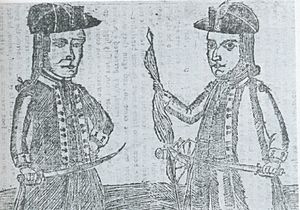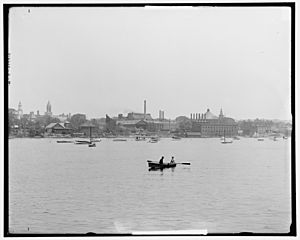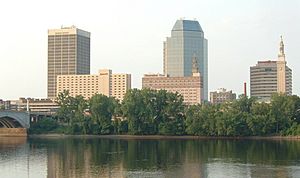History of Springfield, Massachusetts facts for kids
The history of Springfield, Massachusetts began in 1636. It was first called Agawam Plantation, named after a Native American village nearby. It was the northernmost settlement of the Connecticut Colony. After four years, the settlement joined the Massachusetts Bay Colony. The town then changed its name to Springfield.
Springfield was chosen because of its great location. It sits on a bluff overlooking the Connecticut River, where three other rivers join it. This area was a Native American meeting point for two big trade routes. It also has some of the best farming soil in the northeastern United States.
Springfield grew as a trading post. Over time, Native American tribes were moved to a fort on Long Hill. During King Philip's War in 1675, Native Americans attacked and destroyed Springfield. After being rebuilt, Springfield's growth slowed for about 100 years.
In 1777, during the American Revolutionary War, leaders made Springfield a National Armory. This was a place to store weapons. By 1795, it started making muskets. The Armory made small arms until 1968. It created famous weapons like the Springfield rifle and the M1 Garand. The Armory brought many skilled workers to the city. This made Springfield a major center for precision manufacturing.
Springfield also saw many important inventions. These include the first American English dictionary (1805), the first use of interchangeable parts and the assembly line (1819), and the first American gasoline-powered car (1893). Most famously, basketball was invented here in 1891 by Dr. James Naismith.
Contents
17th Century: How Springfield Began
Colonial Settlement: A New Home

In 1635, a Puritan businessman named William Pynchon sent people to find the best place in the Connecticut River Valley for farming and trading. They found the Native American village of Agawam. This was on the west side of the Connecticut River. The land was good for farming because it was clear of trees and had rich soil.
In 1636, Pynchon led a group of settlers to Agawam. They chose a spot just north of Enfield Falls. This was a waterfall where boats had to stop and move their goods. By settling here, Pynchon became the main trader on the Connecticut River. He built a warehouse in what is now East Windsor, Connecticut.
Pynchon learned the local Native American language. He heard warnings that the west side of the river often flooded. So, he told the settlers to move to the east side, between the Chicopee and Mill Rivers. This spot was higher and safer from floods.
In 1636, Pynchon's group bought land on both sides of the river from 18 Native American tribesmen. They paid with hoes, wampum (beads), coats, hatchets, and knives. The Native Americans kept their hunting and farming rights. They also got paid if English cattle ruined their crops. The English settlement was named Agawam Plantation. It was part of the Connecticut Colony.
Leaving Connecticut: Joining Massachusetts
In 1640, Springfield decided to leave the Connecticut Colony. This changed the borders of the Connecticut River Valley forever. Springfield had been governed by Connecticut, along with Wethersfield, Hartford, and Windsor.
In 1640, there was a shortage of grain. The Connecticut Colony asked William Pynchon to buy corn from the Native Americans. Pynchon refused to pay very high prices. The leaders in Hartford were angry. They sent Captain John Mason to Springfield. Mason threatened the Native Americans with war if they did not sell their corn. They eventually sold it. But Mason's actions made the Native Americans distrust the English more. Mason also publicly criticized Pynchon.
Because of these problems, Pynchon and the settlers of Agawam voted to leave the Connecticut Colony. The Massachusetts Bay Colony then decided to take control of the land around Agawam.
Another disagreement happened over a toll. Connecticut demanded that Springfield's boats pay a toll at the mouth of the Connecticut River. Pynchon refused. When the Massachusetts Bay Colony heard this, they sided with Pynchon. They threatened to make Connecticut ships pay a toll in Boston Harbor. Connecticut quickly dropped its tax on Springfield.
After all this, Pynchon was named a leader by the Massachusetts Bay Colony. The settlement was renamed Springfield, after Pynchon's birthplace in England. For many years, Springfield was the westernmost settlement in Massachusetts.
Early "Firsts": New Beginnings
Springfield had many "firsts" in early American history. In 1645, Springfield had America's first accusations of witchcraft. A woman named Mary Parsons accused another woman of witchcraft. Mary was found guilty of slander. Later, Mary Parsons was accused of witchcraft and of killing her own child. She also accused her husband of witchcraft. Both were found not guilty of witchcraft. But Mary was found guilty of killing her child and died in prison.
William Pynchon was the first person in the New World to commercially package meat. In 1641, he started exporting barrels of salted pork. In 1650, he wrote the New World's first banned book, The Meritous Price of Our Redemption. This book was critical of the Puritan religion. It was burned in Boston. Pynchon was accused of heresy. In 1652, he moved back to England.
William's son, John Pynchon, and his brother-in-law, Elizur Holyoke, took over leadership. They shifted Springfield's focus from fur trading to farming. In 1655, John Pynchon led America's first cattle drive. He moved a herd from Springfield to Boston.
Springfield's land grew as more land was bought from Native Americans. Over time, parts of Springfield were used to form other towns. But Springfield remained the largest and most important city in the region.
King Philip's War: A Time of Conflict
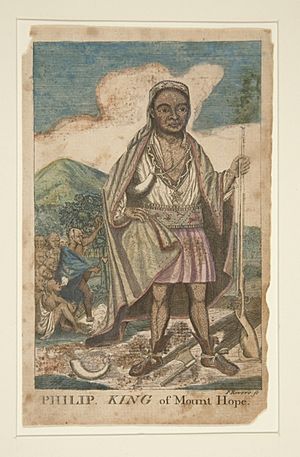
For years, English settlers took more and more Native American land. European diseases also greatly reduced the Native population. The leader of the Wampanoag tribe, Wamsutta, died after being questioned by colonists. His brother, Chief Metacomet, known as "King Philip," sought revenge.
King Philip encouraged the Agawam Native Americans near Springfield to rebel. They attacked and burned Springfield in 1675. Springfielders were warned by a Native American named Toto from Windsor, Connecticut. Despite the warning, 45 of Springfield's 60 houses were burned. John Pynchon's mills were also destroyed.
After the attack, some thought about leaving Springfield. But they decided to rebuild. Residents survived the winter of 1675 under siege. Captain Miles Morgan's block-house became a fortress. He held out until help arrived from Hadley. Both of Captain Miles Morgan's sons died defending Springfield. Today, a statue of Miles Morgan stands in Springfield's Court Square.
King Philip's War was very violent. Thousands of settlers and Native Americans died. It ended in 1676 when Metacomet was killed. After the war, Native Americans mostly disappeared from the area. Fighting between Native Americans (and their French allies) and English colonists continued for over 100 years.
Today, a hill where King Philip is said to have encouraged the attack is called King Philip's Stockade. It is a city park with great views of the Connecticut River.
18th Century: The Armory and a Rebellion
The Springfield Armory: A National Treasure
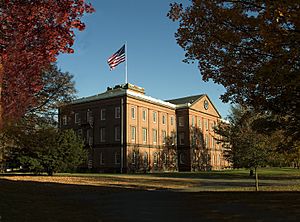
In the 1770s, George Washington chose a high bluff in Springfield for the U.S. National Armory. He picked Springfield because it was central to important cities and resources. It also had easy access to the Connecticut River and major roads. Washington's officer Henry Knox noted that Springfield was far enough upriver to be safe from most sea attacks.
During the American Revolutionary War, the arsenal provided supplies for American forces. It stored muskets, cannons, and other weapons. It also made paper cartridges. After the war, the government kept the facility to store arms.
By the 1780s, the Arsenal was the largest weapons depot in the United States. This made it a target during Shays' Rebellion (see below). In 1794, Congress officially created the Springfield Armory. In 1795, it made the first American-made musket. It produced 245 muskets that year. Until it closed in 1968, the Armory developed and made most of the weapons used by American soldiers. Its presence helped Springfield become known as the "City of Progress" and later the "City of Firsts."
The term Springfield Rifle can refer to any weapon made by the Armory for the U.S. armed forces. Other famous weapons invented here include the Repeating Pistol and the Semi-automatic M1 Garand.
Today, the Armory's land is managed by Springfield Technical Community College and the National Park Service. Most buildings were built in the 19th century. The oldest is from 1808.
Shays' Rebellion: A Fight for Fairness
Shays' Rebellion was the first major revolt by common people in the United States. It was fought at the Springfield Armory in 1787. This rebellion led to big changes in the U.S. government. It showed that the original Articles of Confederation were too weak. This prompted the creation of the U.S. Constitution, which gave more power to the federal government. George Washington came out of retirement because of it.
The rebellion was led by American Revolutionary War soldier Daniel Shays. In January 1787, Shays and his followers, called "Regulators," tried to seize the Arsenal at Springfield. The Arsenal held many weapons and supplies. If the Regulators had captured it, they would have had much more power than the government of Massachusetts.
Court Shutdowns: Protests Against Injustice
In July 1786, farmers and war veterans in Western Massachusetts met to list their complaints about the 1780 Massachusetts State Constitution. They wanted changes, like moving the state legislature out of Boston. They also complained about the expensive court system and the lack of paper money to pay taxes.
The Massachusetts State Legislature ignored their complaints. So, the "Regulators" started gathering in large groups. They forced the closure of county courts across Massachusetts. They even shut down the Supreme Judicial Court in Springfield.
Massachusetts Governor Bowdoin and other leaders, like Samuel Adams, did not sympathize with the Regulators. Samuel Adams even wanted them "put to death immediately." Governor Bowdoin sent militias to protect Springfield. However, many militia members supported the Regulators and joined them instead. News of the rebellion reached the Continental Congress. They authorized troops to stop the rebellion.
The Battle at the U.S. Arsenal
By January 1787, thousands of men had joined the Regulators. On January 25, 1787, three Regulator armies planned to attack the U.S. Federal Arsenal at Springfield. Daniel Shays's army was in Palmer. Luke Day's army was in West Springfield. Eli Parsons's army was in Chicopee.
Luke Day changed the attack date to January 26 without telling Shays and Parsons. So, on January 25, Shays and Parsons approached the Arsenal expecting Day's army to be there. General William Shepard's Massachusetts militia was inside the Arsenal. Shepard used the Arsenal's weapons, even though he technically needed permission.
When Shays's and Parsons's forces got close, Shepard's militia was waiting. They fired two cannons directly into Shays's men. Four Regulators were killed, and thirty were wounded. Shays's army ran away. Without Day's reinforcements, the rebels failed to take the Arsenal.
The rebellion eventually ended. Governor Bowdoin said that Americans would fall into "anarchy" if the law was not followed. However, Shays's Rebellion, like the American Revolution, was an armed uprising against what was seen as an unfair government. Its most important legacy is that it led to the creation of the United States Constitution.
19th Century: The City of Progress
Springfield's Innovations: The City of Firsts

Springfield played a big role in the early Industrial Revolution. It is known as The City of Firsts. In the 19th and early 20th centuries, it was called The City of Progress. Springfield has always been a center for new inventions and ideas. For example, in 1819, Thomas Blanchard invented a lathe that led to interchangeable parts and assembly line mass production. This made making weapons at the Springfield Armory faster and cheaper. Blanchard is also credited with inventing the first modern car in Springfield, a steam-powered "horseless carriage."
The first American-English dictionary was made in Springfield in 1806 by Merriam-Webster. Merriam-Webster still has its main office in Springfield today.
Many popular products were invented in Springfield. In 1844, Charles Goodyear perfected and patented vulcanized rubber at his factory in Springfield. In 1856, the world's first adjustable monkey wrench was invented here. In 1873, America's first postcard was invented by the Morgan Envelope Factory. Springfield also hosted America's first horse show (1853) and dog show (1875).
Springfield was also important in the fight against slavery. In 1808, a man from New York (where slavery was legal) came to Springfield to get his escaped slave, Jenny. Jenny had lived in Springfield for years. The citizens of Springfield raised money to buy Jenny's freedom. She lived as a free woman in Springfield.
John Brown, a famous abolitionist, became a national leader in the abolitionist movement while living in Springfield from 1846 to 1850. Springfield was very supportive of abolitionism. Brown met Frederick Douglass and Sojourner Truth here. He also learned about Springfield's successful Underground Railroad. In 1850, after the Fugitive Slave Act was passed, John Brown formed his first anti-slavery group in Springfield: The League of Gileadites. This group protected escaped slaves from slave-catchers. After this group was formed, no slave was ever "captured" in Springfield again.
In 1852, Springfield became a city. Before this, in 1848, the northern part of Springfield became Chicopee, Massachusetts. This reduced Springfield's land and population. Springfield's first mayor was Caleb Rice.
The Wason Manufacturing Company of Springfield made America's first sleeping car (also called a Pullman Car) in 1857. This company was one of the first to make railway passenger equipment.
In 1855, the formation of the Republican Party was supported by Samuel Bowles III. He was the publisher of the influential Springfield newspaper, The Republican. The Republican Party took its name from Bowles' newspaper. In 1860, Bowles' friend, Springfield lawyer George Ashmun, was elected chairman of the convention that nominated Abraham Lincoln for president.
In 1856, Horace Smith and Daniel B. Wesson formed Smith & Wesson to make revolvers. Smith & Wesson became one of the largest gun manufacturers in the world. Its headquarters are still in Springfield.
On September 20, 1893, Charles and Frank Duryea built and tested the first American gasoline-powered car in Springfield. The Duryea Motor Wagon Company was the first company to make and sell gasoline-powered cars in 1896. In 1895, the Duryea Motor Wagon won America's first road race.
The Birthplace of Basketball

Springfield is famous worldwide as the birthplace of basketball. In 1891, James Naismith, a theology student, invented basketball at the YMCA International Training School (now Springfield College). He created it to fill the time between football and baseball seasons. The first basketball game ever played was in Springfield. The exact spot is marked by a monument. The first building used as an indoor basketball court is at Wilbraham & Monson Academy.
In 1912, the first specially made basketball was produced in Springfield. Today, Springfield-based Spalding is the world's largest maker of basketballs. They make the official basketball for the National Basketball Association.
Basketball became an Olympic sport in 1936. It is now the world's second most popular sport, after soccer.
The Naismith Memorial Basketball Hall of Fame opened in Springfield in 1968. In 2002, a new, architecturally unique Hall of Fame was built. It is shaped like a giant basketball and lights up at night.
Basketball is a big part of Springfield's culture. The city's professional basketball team, the NBA Development League Springfield Armor, plays in the MassMutual Center. Many basketball events happen in Springfield year-round. These include the Hall of Fame's annual ceremony and college basketball tournaments.
20th Century: Growth and Challenges
The City of Homes and Industry
Springfield's automobile industry grew in the early 1900s. Knox Automobile made America's first motorized fire engines for Springfield's Fire Department in 1905. Springfield had the world's first modern fire department.
In 1901, "Indian" motorcycles became the first successful motorcycle manufacturer in the United States. Their Chief and Scout models were very popular.
Springfield was known worldwide for its precision manufacturing. The American Civil War brought great wealth to Springfield. The city made almost all of the Union Army's small arms. From this time until the mid-20th century, Springfield's homes became very beautiful. This earned Springfield the nickname The City of Homes. Many ornate, older homes, like Victorian "Painted Lady" mansions, still exist today.
By the early 1900s, Springfield had over 10% of all manufacturing plants in Massachusetts. In the 1920s, England's Rolls-Royce chose Springfield for its only manufacturing plant outside England. They built nearly 3000 cars here from 1921 to 1931. Production stopped due to the Great Depression.
Granville Brothers Aircraft made racing aircraft at Springfield Airport from 1929 to 1934. They were famous for their "GeeBee" series.
Springfield also led in mass media. The United States' first commercial radio station, WBZ, was founded in Springfield in 1921. It broadcast from the Hotel Kimball. The first UHF television station in the United States, WWLP, was founded in Springfield in 1953.
U.S. Vice President Thomas R. Marshall once said, "Here is a center from which thought emanates. What is said in Springfield is heard around the world."
The Great Floods of 1936 and 1938
In 1936, during the Great Depression, Springfield suffered a major natural disaster. The Connecticut River flooded, reaching record heights. It covered parts of the South End and North End neighborhoods. Damages were estimated at $200,000,000 in 1936 money.
Much of the damage was repaired with WPA money. However, two years later, high flood waters hit Springfield again. This was made worse by the 1938 New England hurricane on September 21, 1938.
Because of these two Great Floods, large parts of the North End and South End neighborhoods no longer exist.
Interstate 91: A River Divided
In the 1960s, I-91 was built along Springfield's riverfront. This highway blocked people's access to the Connecticut River. This land was once very valuable for business and recreation.
The original plan for I-91 was to build it on the west bank of the Connecticut River, through West Springfield. But Springfield city officials pushed for it to cross the river through Springfield's neighborhoods. They thought it would bring economic growth. However, this decision cut off Springfield from its greatest natural resource. It became a famous and unfortunate example of urban renewal.
The highway's design flaws caused problems. Few businesses could benefit from highway traffic. So, Springfield did not get the promised economic boost. In fact, the highway's construction happened at the start of Springfield's economic decline. I-91 was built as an elevated highway, blocking river views downtown. It also sliced through desirable neighborhoods and historical landmarks. This contributed to people moving from the city to the suburbs.
In 2010, a plan was proposed to reconnect Springfield with the Connecticut River. Many Springfielders are excited about this idea.
A Changing City: Population and Economy
In 1968, the Springfield Armory was closed. After this, many precision manufacturing companies left Springfield for places with lower taxes. However, Springfield did not lose as many residents as other Northeast American cities. The departure of wealthy and middle-class residents was balanced by an increase in Hispanic immigrants, especially from Puerto Rico. This changed Springfield's demographics.
Springfield's economy is now based on healthcare, higher education, and transportation. Smith & Wesson still adds jobs. Major private medical investments include Baystate Health's "Hospital of the Future." This $300 million project will add many new doctors.
Springfield's colleges are also growing. Springfield College and Western New England University built new facilities. The University of Massachusetts Amherst moved its Urban Design program and radio station to Springfield.
Springfield is also investing in rail. A high-speed rail line is planned between Springfield and New Haven, Connecticut. This will be the first truly "high-speed train" in the United States.
21st Century: Tornado and Recovery
Springfield Tornado of June 1, 2011
On June 1, 2011, Springfield was hit by a powerful tornado. Its winds were estimated at 160 miles per hour. It was the second largest tornado to hit New England. The tornado caused extensive damage over a path of about 39 miles.
The Springfield Tornado killed four people. Hundreds were injured, and over 500 people became homeless. Many stayed at the MassMutual Center.
The tornado crossed the Connecticut River into Springfield. It damaged the Connecticut River Walk Park. Then it hit Court Square, Springfield's historic center. It ripped parts off the Old First Church and uprooted many old trees. The tornado then moved down Main Street, destroying much of the historic Italian South End.
After devastating the South End, the tornado moved east. It caused significant damage on Maple Street and to the campus of MacDuffie School. Large parts of Springfield College and the Old Hill neighborhood were destroyed. Hundreds of homes in East Forest Park were also damaged. Cathedral High School was completely ruined. Debris from Cathedral was found 43 miles away. The upper-middle-class neighborhood of Sixteen Acres also had significant damage. Over 100 homes in Springfield were completely destroyed.
Following the tornado, Governor Deval Patrick declared a "State of Emergency." U.S. Senator John Kerry said the damages were "astronomical." Insurance claims quickly reached over $140 million.
"Firsts" in Springfield: A Legacy of Innovation



Springfield is known as the City of Firsts because its citizens have created many new products, organizations, and ideas throughout history. The most famous "first" is basketball, invented in 1891. It is now the world's second most popular sport. Here is a partial list of Springfield's "firsts":
- First Springfield in the New World (1636) – William Pynchon
- First Accusation of Witchcraft in the New World (1640) – Mary and Hugh Parsons
- First Meat Packer (exporting salt pork) (1641) – William Pynchon
- First banned book in the New World (1651) – William Pynchon
- First Federal Arsenal (1777) – Springfield Armory, founded by George Washington and Henry Knox
- First Armory in the United States (1794) – Springfield Armory
- First American-Made Musket (1795) – Springfield Armory
- First American-English Dictionary (1806) – Merriam-Webster, Inc.
- First Lathe (leading to interchangeable parts and assembly line mass production) (1820) – Thomas Blanchard
- First Modern Burning Steam Carriage (1826) –Thomas Blanchard
- First Kitchen Friction Match (1834) – Chapin & Phillips Company
- First Vulcanization of Rubber (1844) – Charles Goodyear
- First Clamp-On Ice Skate (1849) – Everett Hosmer Barney
- First National Horse Show in United States (1853)
- First Adjustable Monkey Wrench (1854) – Bemis & Call Company
- Naming of the United States Republican Party (1855) – Samuel Bowles
- First American Railroad Sleeping Car (also known as Pullman Car) (1857) – Wason Company
- First American Popular Parlor Game (1860) – The Game of Life by the Milton Bradley Company
- Pocket-Size Travel Games (1861) – Game for Soldiers by the Milton Bradley Company
- First United States Registered Bank (1863) – National Bank of Springfield
- First Producer of Supplementary Education Material for Kindergarten Education (1869) – Milton Bradley Company
- First Postcard in United States (1873) – Morgan Envelope Factory
- First Dog Show in United States (1875) – Springfield Rod & Gun Club
- First Social Service Agency in United States (1877) – Union Relief Association
- First Planned Residential Neighborhood – The McKnight Historic District (1881) – John and William McKnight
- First Music Appreciation Course (1882) – Springfield Public Schools
- First Revolver Club (1886)
- First Game of Basketball (1891) – Dr. James Naismith of Springfield College
- First Gasoline-powered Automobile (1893) – Charles E and J. Frank Duryea
- First Public Swimming Pool in United States (1899) – Forest Park
- First Successful Motorcycle (1901) – Indian Motorcycle
- First Window Envelope (1902) – U. S. Envelope Company
- First Modern, Motorized Fire Engine (1905) – Knox Automobile
- First Modern, Motorized Fire Department (1907) – Springfield Fire Department
- First Camp Fire Girls (1910) – Charlotte Guilick
- First Factory Air Conditioning (1911) – Bosch Magneto Company
- First Agricultural Course (1912) – Hampden County Improvement League
- First Physical Education Course (1912) – International Y. M. C. A. College (Springfield College)
- First Basketball (1912) – Victor Sporting Goods Company of Springfield
- First American Military Regiment Decorated by a Foreign Power (France, with Croix de Guerre) (1918) – 104th Infantry Regiment
- First Community Chest (1918)
- First Junior Achievement (1919) – Horace A. Moses
- First Rolls Royce American Automobile Plant (1920) – Frederick Royce
- First Commercial Radio Station in United States (1921) – WBZA, located at The Hotel Kimball
- First Test Market for Frozen Foods (1930) – Clarence Birdseye
- First American Built Planetarium (1937) – Springfield Science Museum
- First Fluorescent Lighting System (1939) – Springfield Armory
- First American Discount Store (1949) – King's
- First UHF TV Station in United States (1953) – WWLP-22News
Images for kids
-
Nineteenth-century depiction of William Pynchon being confronted by Captain John Mason, for his decision to not purchase corn from the Pocomtuc
-
Interstate 91 in 1969, just after completion of the viaduct which would separate Springfield from the Connecticut River, St. Joseph's Church and the Campanile can be seen in the foreground, as well as an incomplete Tower Square





